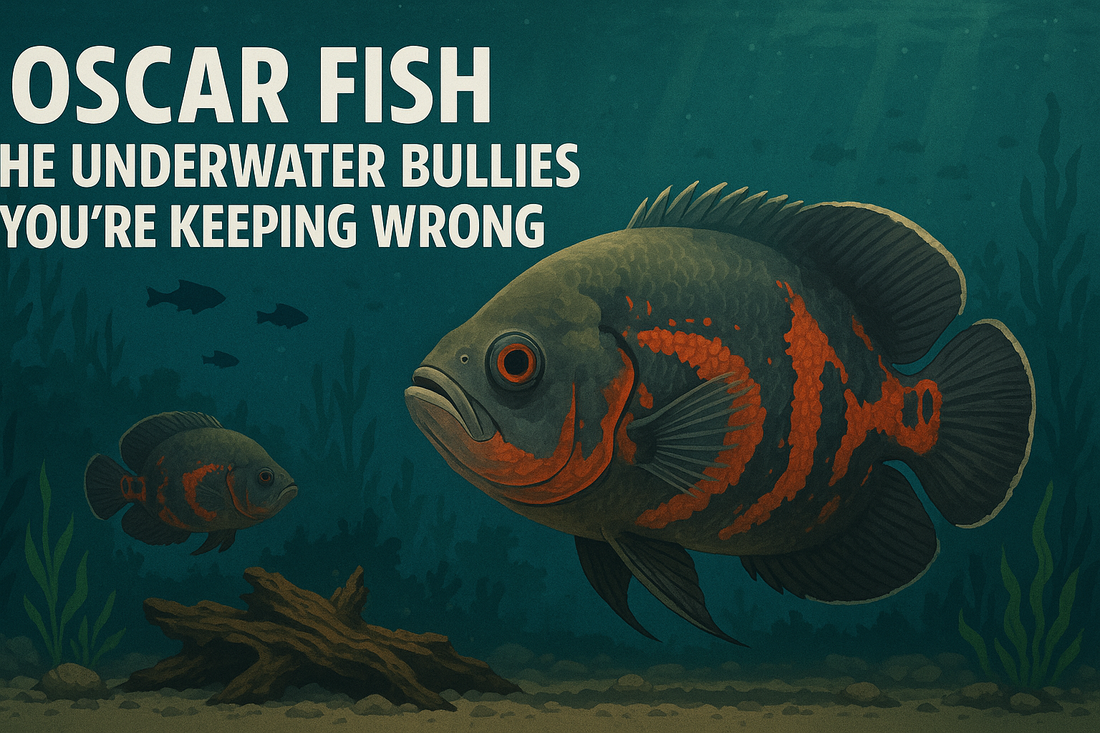1. Origin, History, and Appearance
Origin & Natural History

Oscar fish (Astronotus ocellatus) originate from the Amazon River Basin, specifically in Brazil, Peru, Colombia, and Venezuela. They are found in slow-moving rivers, floodplains, and oxbow lakes, where they thrive in warm, soft, slightly acidic waters with plenty of submerged vegetation and fallen branches.
First introduced into the aquarium trade in the early 1900s, Oscars quickly became popular due to their intelligence, aggressive personality, and dog-like behavior, making them one of the most interactive freshwater fish.
Geography (Natural or Manmade)
Found in slow-moving, warm waters of the Amazon and its tributaries.
Known to modify their environment by digging and rearranging substrate.
Appearance
Size: 12–18 inches (30–45 cm) in captivity, larger in the wild.
Shape: Oval-shaped, muscular body with a large mouth.
Colors: Commonly black with orange, red, or yellow patterns, but variations exist.
Distinguishing Features: Large, fan-like tail and "oscar eye spots" (ocelli) near the base of the tail, which help deter predators.
2. Varieties & Selective Breeding

Natural Variants
Wild Oscar Fish – Dark brown or greenish body with faint patterns.
Tiger Oscar – Black body with bright orange-red markings resembling tiger stripes.
Selective Breeding Varieties
Albino Oscar – White body with red markings, red eyes.
Lutino Oscar – Golden yellow with red highlights.
Red Oscar – Solid red or orange body.
Lemon Oscar – Bright yellow body with pale eyes.
Veil Tail Oscar – Longer, flowing fins for an elegant appearance.
3. Natural Habitat & Food in the Wild
Habitat
Found in muddy riverbeds, flooded forests, and slow-moving tributaries.
Prefer areas with submerged logs, overhanging plants, and sandy or muddy substrates.
Diet in the Wild
Oscar fish are carnivorous omnivores, feeding on:
Live fish & small invertebrates – Shrimp, snails, worms.
Insects & larvae – Mosquito larvae, crickets.
Fruits & plant matter – Occasionally consume fallen fruits.
4. Tank Size

Minimum tank size: 75 gallons (for a single Oscar).
Ideal tank size: 125+ gallons (for a pair or community setup).
Oscars grow fast and need plenty of swimming space.
5. Water Parameters
Temperature: 24–28°C (75–82°F).
pH: 6.5–7.5.
Hardness: 5–20 dGH.
Filtration: Strong filtration is required due to their high waste production.
Lighting: Moderate, not too bright.
6. Natural Behavior & In-Tank Behavior
Highly intelligent and interactive – Recognize owners and can be trained to take food from hand.
Territorial and aggressive – Especially during breeding or in smaller tanks.
Enjoy rearranging their environment – Often uproot plants and move decorations.
Can be aggressive toward tank mates if not properly introduced.
7. Tank Setup & Décor
Best Environment for Oscars.
Substrate: Sand or smooth gravel (avoid sharp rocks).
Live Plants: Not recommended—Oscars dig and uproot them.
Décor: Large rocks, driftwood, and heavy decorations (ensure they can’t be knocked over).
Filtration: Canister filters or sump systems for handling high bio-load.
8. Life Span & Growth Rate
Lifespan: 10–15 years, sometimes longer with excellent care.
Growth Rate: 1 inch per month in the first year, reaching full size in 12–18 months.
9. Ideal Tank Mates
Compatible Fish
Other large cichlids: Severums, Jack Dempseys, Green Terrors (if introduced properly).
Bottom-dwellers: Large Plecos, Fire Eels, Bichirs.
Other large, semi-aggressive fish: Silver Dollars, Arowanas (in massive tanks).
Fish to Avoid
Small fish: Guppies, Neon Tetras (they WILL be eaten).
Weak or slow fish: Angelfish, Discus (may get bullied).
Overly aggressive fish: Flowerhorns, Red Devil Cichlids (can lead to fights).
10. Common Diseases & Problems

Common Illnesses
Hole-in-the-Head Disease (HITH): Caused by poor diet and water conditions.
Ich (White Spot Disease): Can occur due to stress or poor water quality.
Fin Rot: Caused by bacterial infections from injuries.
Bloat: Overfeeding or poor-quality food can lead to digestive issues.
Prevention & Treatment
Weekly water changes (30–50%) to maintain water quality.
Avoid overfeeding – Stick to a balanced diet.
Quarantine new fish before introducing them to the main tank.
11. Best Food in Captivity
Ideal Diet for Oscars
Life Aayu Cichlid Regular Fish Food is specially crafted for all types of Cichlid fish,
providing a digestion-friendly and immunity-boosting diet. Made with natural
Ayurvedic ingredients, this food supports vibrant health, strong immunity, and better
growth. Enriched with Beta-carotene, shrimp meal, spirulina, and astaxanthin, it
promotes optimal fish health and vibrant coloration.
Feeding Instruction
Follow the 1,2 ka 4 Formula:
Feed one fish, two times a day, approximately four pellets of Cichlid Regular Fish
Food per feed. Ensure fish consume it in 2-3 minutes, and remove uneaten food.
12. Male & Female Differences
Males: Slightly larger, more pronounced forehead bump.
Females: Rounder body when carrying eggs.
Difficult to distinguish unless breeding.
13. Breeding
Breeding Behavior
Form monogamous pairs – Can be aggressive toward other fish during breeding.
Lay eggs on flat surfaces – Rocks, glass, or large decorations.
Both parents protect and fan the eggs.
Breeding Requirements
Separate breeding tank: 75+ gallons for a pair.
Water temperature: 27–28°C (80–82°F).
Fry hatch in 3–4 days and become free-swimming within a week.
Fry Care
Feed newly hatched brine shrimp or powdered fry food.
Keep water clean to prevent fungal infections.
14. Coloration & Mood Changes
Darkening colors = stress, illness, or aggression.
Brighter colors = breeding readiness or excitement.
Faded colors = poor water quality or nutritional deficiency.
15. Unique Aspects & Additional Tips for Fishkeepers
Oscars are known as "water puppies" due to their ability to recognize and interact with owners. They can sulk or refuse food after changes in their environment. They require strong, stable filtration to handle their high waste output. They are escape artists – ensure lids are secure.
Conclusion: The Truth About Keeping Oscars
Oscars are not for casual fishkeepers. They are intelligent, aggressive, and demanding, requiring large tanks, strong filtration, and proper care. If you don’t plan for their size, aggression, and messy eating habits, your Oscar will suffer from stunted growth and health issues.
Are you really ready for an Oscar? If so, follow this guide, and you’ll have a bold, interactive, and long-lived fish that will feel like a true pet rather than just an aquarium decoration!




1 comment
Great tips! I especially agree with your point about not overfeeding. I also wrote something similar for busy people who care for aquariums only on weekends — check out https://www.weekendaquarist.in.
Thanks for sharing such helpful content!